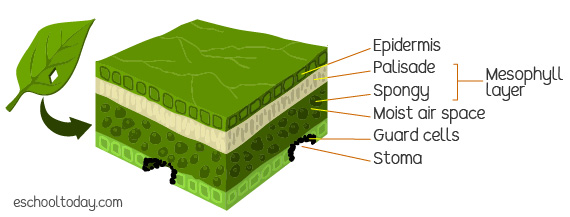- Photosynthesis
The basic structure of a leaf
Our study of photosynthesis will not be complete without knowing more about the structure of a leaf. The leaf is adapted to play a vital role in the process of photosynthesis. Here is how:
- Wide surface area
Most green plants have leaves that are broad, flat, and exposed to capture as much of the sun’s energy (sunlight) needed for photosynthesis. - Veins
The network of veins in the leaf also carries water from the stems to the leaves. Glucose produced is also sent to the other parts of the plant from the leaves through the veins. Additionally, the veins support and hold the leaf flat to capture sunlight. - Pores (holes)
The stomata (tiny holes underneath the leaf) allows air in and out of the leaf. Stomata (single is called stoma) is usually at the bottom surface of the leaf but some plant species have them on the upper surface whiles others have them on both sides.
The stomata close in the night to retain gases and moisture in the leaf cells and opens during the day for gaseous exchange to continue.
Below is a close diagram of the leaf structure:

Take a good look at the diagram and the various parts of the leaf structure. It will be very useful on the next page.
